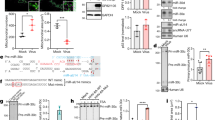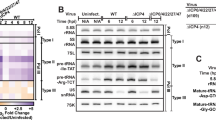Abstract
The discovery of RNA interference and cellular microRNAs (miRNAs) has not only affected how biological research is conducted but also revealed an entirely new level of post-transcriptional gene regulation. Here, I discuss the potential functions of the virally encoded miRNAs recently identified in several pathogenic human viruses and propose that cellular miRNAs may have had a substantial effect on viral evolution and may continue to influence the in vivo tissue tropism of viruses. Our increasing knowledge of the role and importance of virally encoded miRNAs will probably offer new insights into how viruses that establish latent infections, such as herpesviruses, avoid elimination by the host innate or adaptive immune system. Research into viral miRNA function might also suggest new approaches for treating some virally induced diseases.
This is a preview of subscription content, access via your institution
Access options
Subscribe to this journal
Receive 12 print issues and online access
$209.00 per year
only $17.42 per issue
Buy this article
- Purchase on Springer Link
- Instant access to full article PDF
Prices may be subject to local taxes which are calculated during checkout

Katie Ris

Katie Ris
Similar content being viewed by others
References
Bartel, D.P. MicroRNAs: Genomics, biogenesis, mechanism, and function. Cell 116, 281–297 (2004).
Stark, A., Brennecke, J., Bushati, N., Russell, R.B. & Cohen, S.M. Animal microRNAs confer robustness to gene expression and have a significant impact on 3′UTR evolution. Cell 123, 1133–1146 (2005).
Farh, K.K. et al. The widespread impact of mammalian microRNAs on mRNA repression and evolution. Science 310, 1817–1821 (2005).
Cullen, B.R. Transcription and processing of human microRNA precursors. Mol. Cell 16, 861–865 (2004).
Cai, X., Hagedorn, C.H. & Cullen, B.R. Human microRNAs are processed from capped, polyadenylated transcripts that can also function as mRNAs. RNA 10, 1957–1966 (2004).
Lee, Y. et al. MicroRNA genes are transcribed by RNA polymerase II. EMBO J. 23, 4051–4060 (2004).
Lee, Y. et al. The nuclear RNase III drosha initiates microRNA processing. Nature 425, 415–419 (2003).
Denli, A.M., Tops, B.B.J., Plasterk, R.H.A., Ketting, R.F. & Hannon, G.J. Processing of primary microRNAs by the microprocessor complex. Nature 432, 231–235 (2004).
Gregory, R.I. et al. The microprocessor complex mediates the genesis of microRNAs. Nature 432, 235–240 (2004).
Yi, R., Qin, Y., Macara, I.G. & Cullen, B.R. Exportin-5 mediates the nuclear export of pre-microRNAs and short hairpin RNAs. Genes Dev. 17, 3011–3016 (2003).
Lund, E., Güttinger, S., Calado, A., Dahlberg, J.E. & Kutay, U. Nuclear export of microRNA precursors. Science 303, 95–98 (2004).
Zeng, Y. & Cullen, B.R. Structural requirements for pre-microRNA binding and nuclear export by Exportin 5. Nucleic Acids Res. 32, 4776–4785 (2004).
Chendrimada, T.P. et al. TRBP recruits the Dicer complex to Ago2 for microRNA processing and gene silencing. Nature 436, 740–744 (2005).
Hutvágner, G. et al. A cellular function for the RNA-interference enzyme Dicer in the maturation of the let-7 small temporal RNA. Science 293, 834–838 (2001).
Hammond, S.M., Bernstein, E., Beach, D. & Hannon, G.J. An RNA-directed nuclease mediates post-transcriptional gene silencing in Drosophila cells. Nature 404, 293–295 (2000).
Maniataki, E. & Mourelatos, Z. A human, ATP-independent, RISC assembly machine fueled by pre-miRNA. Genes Dev. 19, 2979–2990 (2005).
Liu, J. et al. Argonaute2 is the catalytic engine of mammalian RNAi. Science 305, 1437–1441 (2004).
Meister, G. et al. Human Argonaute2 mediates RNA cleavage targeted by miRNAs and siRNAs. Mol. Cell 15, 185–197 (2004).
Schwarz, D.S., Hutvágner, G., Haley, B. & Zamore, P.D. Evidence that siRNAs function as guides, not primers, in the Drosophila and human RNAi pathways. Mol. Cell 10, 537–548 (2002).
Zeng, Y., Yi, R. & Cullen, B.R. MicroRNAs and small interfering RNAs can inhibit mRNA expression by similar mechanisms. Proc. Natl. Acad. Sci. USA 100, 9779–9784 (2003).
Yekta, S., Shih, I.H. & Bartel, D.P. MicroRNA-directed cleavage of HOXB8 mRNA. Science 304, 594–596 (2004).
Hutvágner, G. & Zamore, P.D. A microRNA in a multiple-turnover RNAi enzyme complex. Science 297, 2056–2060 (2002).
Olsen, P.H. & Ambros, V. The lin-4 regulatory RNA controls developmental timing in Caenorhabditis elegans by blocking LIN-14 protein synthesis after the initiation of translation. Dev. Biol. 216, 671–680 (1999).
Zeng, Y., Wagner, E.J. & Cullen, B.R. Both natural and designed micro RNAs can inhibit the expression of cognate mRNAs when expressed in human cells. Mol. Cell 9, 1327–1333 (2002).
Doench, J.G., Petersen, C.P. & Sharp, P.A. siRNAs can function as miRNAs. Genes Dev. 17, 438–442 (2003).
Zeng, Y. & Cullen, B.R. Sequence requirements for microRNA processing and function in human cells. RNA 9, 112–123 (2003).
Pfeffer, S. et al. Identification of microRNAs of the herpesvirus family. Nat. Methods 2, 269–276 (2005).
Cai, X. et al. Kaposi's sarcoma-associated herpesvirus expresses an array of viral micro-RNAs in latently infected cells. Proc. Natl. Acad. Sci. USA 102, 5570–5575 (2005).
Pfeffer, S. et al. Identification of virus-encoded microRNAs. Science 304, 734–736 (2004).
Grey, F. et al. Identification and characterization of human cytomegalovirus-encoded microRNAs. J. Virol. 79, 12095–12099 (2005).
Sullivan, C.S., Grundhoff, A.T., Tevethia, S., Pipas, J.M. & Ganem, D. SV40-encoded microRNAs regulate viral gene expression and reduce susceptibility to cytotoxic T cells. Nature 435, 682–686 (2005).
Andersson, M.G. et al. Suppression of RNA interference by adenovirus virus-associated RNA. J. Virol. 79, 9556–9565 (2005).
Sano, M., Kato, Y. & Taira, K. Sequence-specific interference by small RNAs derived from adenovirus VA1 RNA. FEBS Lett. 580, 1553–1564 (2006).
Cai, X. et al. Epstein-Barr virus microRNAs are evolutionarily conserved and differentially expressed. PLoS Pathog. 2, e23 (2006).
Grundhoff, A., Sullivan, C.S. & Ganem, D. A combined computational and microarray-based approach identifies novel microRNAs encoded by human gamma-herpesviruses. RNA 12, 1–18 (2006).
Mathews, M.B. & Shenk, T. Adenovirus virus-associated RNA and translation control. J. Virol. 65, 5657–5662 (1991).
Thimmappaya, B., Weinberger, C., Schneider, R.J. & Shenk, T. Adenovirus VA1 RNA is required for efficient translation of viral mRNAs at late times after infection. Cell 31, 543–551 (1982).
Gwizdek, C. et al. Terminal minihelix, a novel RNA motif that directs polymerase III transcripts to the cell cytoplasm. J. Biol. Chem. 276, 25910–25918 (2001).
Ma, J.B., Ye, K. & Patel, D.J. Structural basis for overhang-specific small interfering RNA recognition by the PAZ domain. Nature 429, 318–322 (2004).
Lu, S. & Cullen, B.R. Adenovirus VA1 noncoding RNA can inhibit small interfering RNA and microRNA biogenesis. J. Virol. 78, 12868–12876 (2004).
Aparicio, O., Razquin, N., Zaratiegui, M., Narvaiza, I. & Fortes, P. Adenovirus virus-associated RNA is processed to functional interfering RNAs involved in virus production. J. Virol. 80, 1376–1384 (2006).
Fraser, N.W., Block, T.M. & Spivack, J.G. The latency-associated transcripts of herpes simplex virus: RNA in search of function. Virology 191, 1–8 (1992).
Branco, F.J. & Fraser, N.W. Herpes simplex virus type 1 latency-associated transcript expression protects trigeminal ganglion neurons from apoptosis. J. Virol. 79, 9019–9025 (2005).
Cai, X. & Cullen, B.R. Transcriptional origin of Kaposi's sarcoma-associated herpesvirus microRNAs. J. Virol. 80, 2234–2242 (2006).
Samols, M.A., Hu, J., Skalsky, R.L. & Renne, R. Cloning and identification of a microRNA cluster within the latency-associated region of Kaposi's sarcoma-associated herpesvirus. J. Virol. 79, 9301–9305 (2005).
Furnari, F.B., Adams, M.D. & Pagano, J.S. Unconventional processing of the 3′ termini of the Epstein-Barr virus DNA polymerase mRNA. Proc. Natl. Acad. Sci. USA 90, 378–382 (1993).
Tortorella, D., Gewurz, B.E., Furman, M.H., Schust, D.J. & Ploegh, H.L. Viral subversion of the immune system. Annu. Rev. Immunol. 18, 861–926 (2000).
Katze, M.G., He, Y. & Gale, M.G. Jr. Viruses and interferon: A fight for supremacy. Nat. Rev. Immunol. 2, 675–687 (2002).
Macrae, A.I. et al. Analysis of a novel strain of murine gammaherpesvirus reveals a genomic locus important for acute pathogenesis. J. Virol. 75, 5315–5327 (2001).
Gitlin, L. & Andino, R. Nucleic acid-based immune system: The antiviral potential of mammalian RNA silencing. J. Virol. 77, 7159–7165 (2003).
Lecellier, C.-H. et al. A cellular microRNA mediates antiviral defense in human cells. Science 308, 557–560 (2005).
Linial, M.L. Foamy viruses are unconventional retroviruses. J. Virol. 73, 1747–1755 (1999).
Jopling, C.L., Yi, M., Lancaster, A.M., Lemon, S.M. & Sarnow, P. Modulation of hepatitis C virus RNA abundance by a liver-specific microRNA. Science 309, 1577–1581 (2005).
Krützfeldt, J. et al. Silencing of microRNAs in vivo with 'antagomirs'. Nature 438, 685–689 (2005).
Acknowledgements
Research from my laboratory described in this manuscript was supported by grant GM071408 from the US National Institutes of Health.
Author information
Authors and Affiliations
Ethics declarations
Competing interests
The author declares no competing financial interests.
Rights and permissions
About this article
Cite this article
Cullen, B. Viruses and microRNAs. Nat Genet 38 (Suppl 6), S25–S30 (2006). https://doi.org/10.1038/ng1793
Published:
Issue Date:
DOI: https://doi.org/10.1038/ng1793
This article is cited by
-
Evaluating the causal association between microRNAs and amyotrophic lateral sclerosis
Neurological Sciences (2023)
-
Cytomegalovirus microRNAs level determination in kidney recipients post transplantation
Virology Journal (2022)
-
MicroRNA profiling of Neospora caninum tachyzoites (NC-1) using a high-throughput approach
Parasitology Research (2021)
-
MicroRNA-324-3p Plays A Protective Role Against Coxsackievirus B3-Induced Viral Myocarditis
Virologica Sinica (2021)
-
Prediction and experimental confirmation of banana bract mosaic virus encoding miRNAs and their targets
ExRNA (2020)



